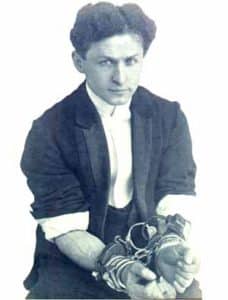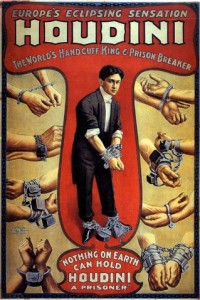The performer known worldwide as Harry Houdini was born on March 24, 1874 in Budapest. Although Houdini often claimed to be born in Appleton, Wisconsin, Houdini actually came to the United States when he was four years old. To this day many connected with the small town of Appleton still claim the untruth that Houdini was born there strictly to attract tourists. Houdini’s father was Mayer Samuel Weiss. Houdini’s father was a Rabbi. His mother’s name was Cecilia Steiner Weiss. His parents spoke little English, and the family was quite poor so most of the children began to work at an early age. From the age of eight young Ehrich Weiss sold newspapers and worked as a shoe shine boy. At the age of 12, young Ehrich left home to make his way in the world in an attempt to help support his family. Young Ehrich traveled the country for about a year, always sending money home when he could. Finally he joined up with his father in New York City. The family moved to New York in the hope of finding a better life there. In New York, Houdini worked as a messenger and as a cutter in a garment center sweat shop, to help support his family. Houdini began performing magic as a teenager first calling himself Eric the Great. Ehrich acquired the name Houdini from a book he read, “The Memoirs of Robert-Houdin,” the autobiography of one of the greatest magicians of the day. Influenced by what he read and learned about the internationally known magician Robert Houdin, young Ehrich changed his name to Houdini, hoping to be in some way like his new found mentor. Houdini’s first magic shows consisted of card tricks and other simple magic. Soon Houdini began experimenting with hand cuffs and using them in his acts. Houdini performed with another young man who worked with him in the factory in New York. They called themselves the Houdini Brothers. Soon Houdini’s younger brother Theo took the place of the boy from the factory. Together with his brother Theo, they tried to succeed as the Houdini Brothers.
Their first performances included shows at amusement parks, beer halls, “dime museums,” and at the Chicago World’s Fair in 1893. In  1894, Houdini met Wilhelmina Beatrice Rahner, who was singing and dancing as part of the Floral Sisters. They were working Coney Island at the time. After knowing each other only two weeks they were married in the month of July. Bess, as she was called, worked and traveled with Houdini. Bess took Theo’s place in the act that would now be called “The Houdini’s”. Houdini began offering rewards to anyone who could successfully restrain him, first in handcuffs and later in all manner of objects. Houdini escaped from handcuffs, leg irons, straight jackets, jails and prison cells, a mail pouch, packing crates, a giant paper bag (without tearing the paper), a giant football, an iron boiler, milk cans, coffins, and the famous Water Torture Cell. Some of Houdini’s escapes, such as the Straight Jacket or being tied with a hundred feet of rope, Houdini would do in full view of the audience. Houdini spent many hours studying, practicing and conditioning. For Houdini’s underwater stunts, Houdini would practice holding his breath in the bathtub for up to four minutes. To help draw crowds and sell tickets, Houdini would do escape challenges, often at police stations with newspaper reporters present, assuring a headline story. Martin Beck, Vaudeville’s most important booking agent caught Houdini’s act in 1899 and was impressed with his dynamic personality and booked him as a “challenge escape artist.” Martin Beck booked the Orpheum circuit, the largest chain of vaudeville theaters in the country and booked all of the stars of vaudeville. He had a trained eye for talent. He immediately placed Houdini in big time vaudeville as a supporting act. Houdini soon began to headline in several theaters throughout the country. After some success in the United States Houdini decided to go to Europe in the year 1900. Houdini created a sensation in London, England and went on to travel throughout Europe for five years as a headliner. Houdini had so much work in Europe that he summoned his brother Theo to work there under the name Hardeen. Houdini returned to the United States, determined to become an even bigger star in the country he loved. He would cris-cross between Europe and the United States going where he could get the biggest offers.
1894, Houdini met Wilhelmina Beatrice Rahner, who was singing and dancing as part of the Floral Sisters. They were working Coney Island at the time. After knowing each other only two weeks they were married in the month of July. Bess, as she was called, worked and traveled with Houdini. Bess took Theo’s place in the act that would now be called “The Houdini’s”. Houdini began offering rewards to anyone who could successfully restrain him, first in handcuffs and later in all manner of objects. Houdini escaped from handcuffs, leg irons, straight jackets, jails and prison cells, a mail pouch, packing crates, a giant paper bag (without tearing the paper), a giant football, an iron boiler, milk cans, coffins, and the famous Water Torture Cell. Some of Houdini’s escapes, such as the Straight Jacket or being tied with a hundred feet of rope, Houdini would do in full view of the audience. Houdini spent many hours studying, practicing and conditioning. For Houdini’s underwater stunts, Houdini would practice holding his breath in the bathtub for up to four minutes. To help draw crowds and sell tickets, Houdini would do escape challenges, often at police stations with newspaper reporters present, assuring a headline story. Martin Beck, Vaudeville’s most important booking agent caught Houdini’s act in 1899 and was impressed with his dynamic personality and booked him as a “challenge escape artist.” Martin Beck booked the Orpheum circuit, the largest chain of vaudeville theaters in the country and booked all of the stars of vaudeville. He had a trained eye for talent. He immediately placed Houdini in big time vaudeville as a supporting act. Houdini soon began to headline in several theaters throughout the country. After some success in the United States Houdini decided to go to Europe in the year 1900. Houdini created a sensation in London, England and went on to travel throughout Europe for five years as a headliner. Houdini had so much work in Europe that he summoned his brother Theo to work there under the name Hardeen. Houdini returned to the United States, determined to become an even bigger star in the country he loved. He would cris-cross between Europe and the United States going where he could get the biggest offers.
As escape artist imitators popped up to take advantage of Houdini’s tremendous success, Houdini began to originate new and more difficult and dangerous escapes. Houdini invented the underwater packing box escape as a fabulous publicity stunt that was copied by many others. He was the first person to do the Straight Jacket Escape as well. He introduced the sensational Milk Can Escape in St.  Louis on January 27, 1908. In 1913 he introduced his legendary Chinese Water Torture Cell. This was the same year his mother died which was a great shock to Houdini. He was in Europe at them time and his family had not told of his mother’s illness. He was also the first to do the largest stage illusion to that day, making the largest object known at the time – an elephant disappear. This was done in 1918 at the Hippodrome in New York City. In 1916 Houdini began a film career. This gave people all over the world a chance to see the great artist. Houdini made five major silent films up until 1923. He also wrote several of them. His films include “The Master Mystery,” “The Grim Game,” “Terror Island” and “The Man From Beyond.” Houdini was given one of the first stars on the Hollywood Walk of Fame for his contribution to the film industry. The star is in a prominent spot out side of Hollywood’s famous Chinese Theater. Houdini wrote and even directed several of his movies. Houdini hated cheats and frauds. Throughout his career Houdini exposed cheats and frauds in the areas of gambling, spiritualism, and psychic frauds.
Louis on January 27, 1908. In 1913 he introduced his legendary Chinese Water Torture Cell. This was the same year his mother died which was a great shock to Houdini. He was in Europe at them time and his family had not told of his mother’s illness. He was also the first to do the largest stage illusion to that day, making the largest object known at the time – an elephant disappear. This was done in 1918 at the Hippodrome in New York City. In 1916 Houdini began a film career. This gave people all over the world a chance to see the great artist. Houdini made five major silent films up until 1923. He also wrote several of them. His films include “The Master Mystery,” “The Grim Game,” “Terror Island” and “The Man From Beyond.” Houdini was given one of the first stars on the Hollywood Walk of Fame for his contribution to the film industry. The star is in a prominent spot out side of Hollywood’s famous Chinese Theater. Houdini wrote and even directed several of his movies. Houdini hated cheats and frauds. Throughout his career Houdini exposed cheats and frauds in the areas of gambling, spiritualism, and psychic frauds.
Houdini never believed in spiritualism, but would often pretend to in order to gain entry to seances. Houdini would write many books and articles throughout his life. They included “The Right Way To Do Wrong,” an expose of swindlers, “A Magician Among The Spirits,” an expose of psychic frauds, and “The Unmasking of Robert-Houdin,” which was up until that time the greatest book on the history of magic. On October 22, 1926, Houdini was in Montreal performing at the Princess Theater. In his dressing room at the theater, while lying on a couch backstage, an young athlete from McGill University, asked if Houdini could actually withstand punches to the stomach as he had heard. Before Houdini could prepare himself by tightening his stomach muscles, the student began to punch the legendary magician in the midsection. Houdini did not know it, but his appendix was ruptured. Houdini did several more shows in Montreal and then headed for Detroit. Houdini did one performance there and then collapsed and was rushed to the hospital. Houdini did not die in an escape or fail in some final escape as many believe. The greatest “ghost buster” of all time died on October 31, 1926, Halloween. No other famous magician worked as hard as Houdini to promote his craft and those around him. Houdini today is one of the best know performers and promoters in theatrical and film history and Houidni’s name has come to mean the ability to escape from any restraint or difficult situation. Houdini not only earned a place in history but in the dictionary as well.
